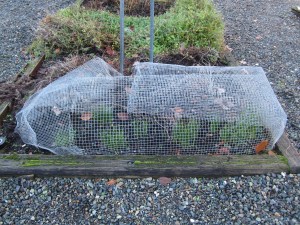In the Medicinal Herb Garden, this was the Year of the Rabbit. There is no rabbit fence on the perimeter to keep them out, so visitors can expect to see hardware cloth covering or surrounding certain plants. It’s not a permanent solution but a necessary one for now. Rabbits, like any living thing, will eat their preferred foods first. If those foods aren’t available, they move on to something else that is. In winter, with less herbaceous growth to consume, they’re forced to eat more woody matter. There’s a lot of energy invested in living wood, so a little damage goes a long way. These wild rabbits seem quite open to trying new plants, a bite here and a bite there, and that’s probably why they do so well. As soon as I enclose one species of shrub they move on to something else.

Don’t try this at home. Felco pruners are great for their intended use of pruning plants. That said, they do a pretty good job cutting hardware cloth.

Gaultheria procumbens (wintergreen or teaberry) was untouched all summer but was being grazed in November. Maybe this and Vaccinium corymbosum (tall bush blueberry), Opuntia humifusa (eastern prickly pear) and Aronia melanocarpa (black chokeberry), all eastern North American natives, are comfort foods for these rabbits that are native to the eastern side of the continent. Maybe, but they also eat Asian, African, European and South American plants. Their gusto is admirable.

Testing some tulle fabric that came my way. It’s a lot easier than cutting and staking hardware cloth. It seems to be protecting the Ephedra chilensis (Andean jointfir, pingo pingo).

This ephedra plant lost about two thirds of its biomass before I discovered the damage. Must be tasty and nutritious, though there’s little or no ephedrine to speak of in this New World species, so they’re unlikely to turn into energizer bunnies.

Patch job to save the Crocus sativus (Saffron crocus), the only member of the Iridaceae that has so far been impacted by rabbits. The legumes, however, were decimated. The Fabaceae could be on their way out or require permanent protection.

The alleged perpetrator, or one of them, caught on the trail camera set up to photograph the coyote. What interest this herbivore would have in a can of rotting tuna, the scent lure, only s/he knows, unless… it’s the Killer Rabbit of Caerbannog.

Love them or hate them, rabbits can now be viewed from the sitting position on our beautiful, brand new memorial bench in section C. It had just been set in concrete when this photo was taken.

This is not a Christmas tree ornament that has seen better days, it is a ripe fruit from the North American native, Passiflora incarnata (maypop) vine. It was a bumper year for the fruit which contain edible pulp and seeds (crunch them with your teeth as you would Concord grape seeds).

The insides of several fruit, ready to ferment for a while, then have the seeds extracted from the soft, sweet, fragrant arils. Seeds will be distributed through the Index Seminum international seed exchange program in which we participate. Many of the obscure plants in the Medicinal Herb Garden come from seeds acquired through this excellent mutual aid coalition.

There’s been a lot of talk of UFOs in the news lately. As the fog burned off one cold morning, through the filtered sunlight in section A, it looked like the mothership was about to land on the garden shed. Maybe it did. Maybe it dropped off more rabbits or took a few back with it.
That’s the last of the news for 2017. Happy solstice.
eating at twilight
and at midday and at night
eastern cottontail
See you in the garden.






That looks like my garden, with chicken wire draped over everything to discourage pooping cats and digging squirrels.